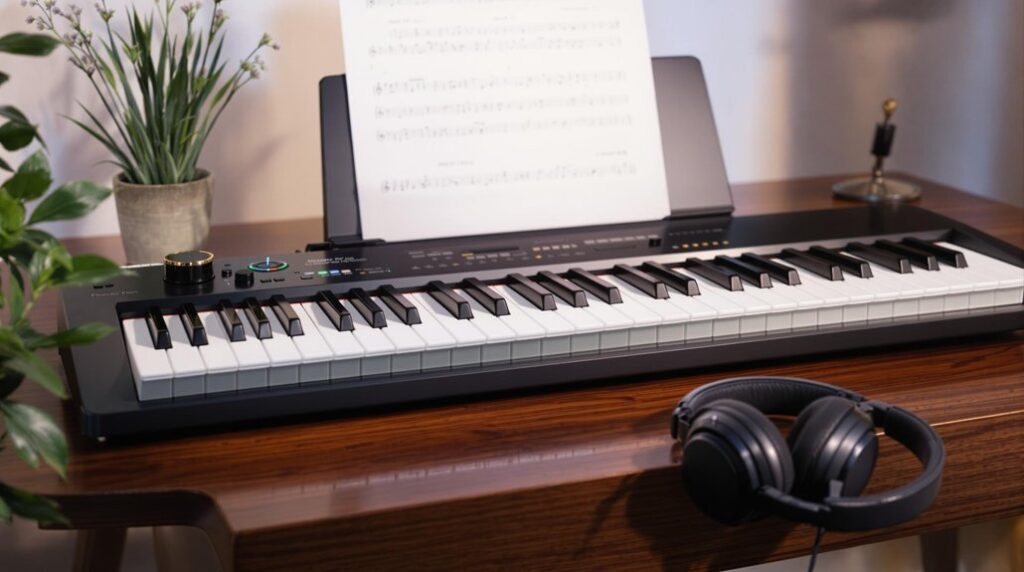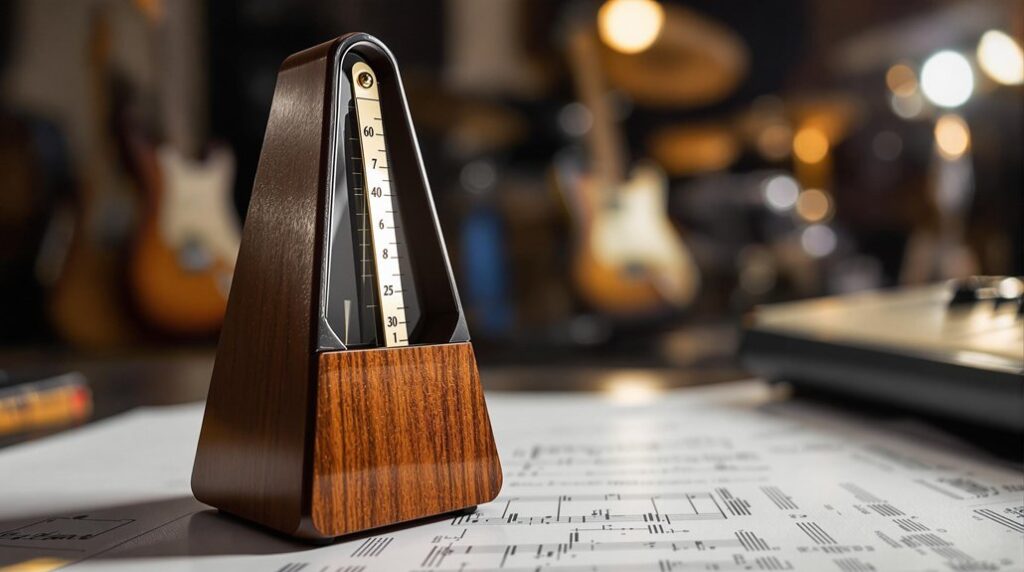Mastering essential ear training drills is crucial for new music producers aiming to refine their auditory precision and enhance production quality. Techniques such as pitch recognition and interval training cultivate a nuanced musical ear, forming the bedrock for enchanting compositions. Systematic chord progression exercises and rhythmic precision tasks, like polyrhythms, evoke emotional resonance and perfect timing. Advanced methods, including solfege and frequency analysis, bolster sound selection and tonal clarity. Consistent practice transforms these skills into a robust creative toolkit, empowering producers with innovation and technical prowess. Explore further to reveal the full potential of your musical artistry.
Key Takeaways
- Engage in regular interval recognition exercises to enhance pitch accuracy and melodic creativity.
- Practice chord progression play-alongs to deepen understanding and evoke emotional resonance in compositions.
- Utilize metronome techniques to refine internal timing and achieve rhythmic precision.
- Transcribe melodies by ear to improve auditory skills and harmonic interaction.
- Explore diverse time signatures to expand rhythmic vocabulary and musical intuition.
Importance of Ear Training
In the field of music production, perception is an invaluable asset that underscores the importance of ear training. By honing ear training skills, producers enhance their capacity to discern pitch recognition, a fundamental aspect that improves both melodic and harmonic replication.
Interval training sharpens auditory acuity, enabling the construction of intricate melodic lines that captivate listeners. Mastery of chord progressions through systematic exercises evokes profound emotional resonance, enriching the musical narrative.
Additionally, rhythmic accuracy is a critical component achieved through consistent practice, ensuring precision in timing and groove. A thorough understanding of musical elements and textures, developed through rigorous ear training, distinguishes producers in the competitive industry, fostering innovation and improving the quality of their compositions and productions. Effective ear training also enhances one’s ability to conduct critical listening during mixing, leading to clearer audio and more polished results.
Pitch Recognition Techniques
Developing acute pitch recognition skills is crucial for music producers aiming to excel in their craft. Pitch recognition, the ability to identify and reproduce musical notes accurately, forms the cornerstone of a seasoned musical ear.
Engaging in ear training exercises, such as singing intervals and employing solfege syllables, enhances tonal memory and pitch communication. Regular practice in varied contexts—like using ear training apps or transcribing melodies—can greatly bolster auditory skills, fostering sharper pitch discernment.
Interval recognition exercises further enhance this foundation, allowing for more intricate melodic creations. Consistent pitch recognition drills, including melody dictation, are essential for mastering sound, offering noticeable improvements in music production capabilities. Additionally, understanding music notation basics is vital for effectively communicating musical ideas.
Therefore, disciplined practice is crucial for refined auditory acuity and musical expression.
Interval Training Exercises
Interval training exercises are fundamental for music producers aiming to sharpen their auditory skills by identifying common intervals, such as major thirds or perfect fifths, which form the backbone of melody and harmony. Engaging in practical application techniques, such as utilizing ear training software and transcribing real music, facilitates a deeper understanding of these intervals’ sonic characteristics and their role in complex musical structures. Additionally, mastering musical scales and modes enhances your ability to create emotionally resonant melodies and harmonies.
Identifying Common Intervals
Mastering the art of identifying common intervals is a pivotal skill for any music producer, as it lays the foundation for enhanced auditory perception and creative prowess. By engaging in ear training techniques specifically designed for interval training exercises, producers hone their pitch recognition skills, enabling them to identify specific frequency ranges with precision. Daily practice in recognizing major seconds, minor thirds, perfect fourths, and perfect fifths enhances the melodic ear, allowing for intuitive musical expression.
| Interval | Step Count | Emotional Response |
|---|---|---|
| Major Second | 2 | Bright, hopeful |
| Minor Third | 3 | Melancholic, reflective |
| Perfect Fourth | 4 | Stable, open |
Integrating real music examples into daily routines solidifies interval recognition, fostering creativity in composition and improvisation by revealing the intricate interplay of musical intervals.
Practical Application Techniques
Effective ear training drills are essential for music producers aiming to refine their interval recognition skills. Mastery of interval training exercises begins with the ability to identify intervals such as major and minor seconds, thirds, and perfect fifths. This foundational skill is vital for enhancing listening skills and the practical application of musical concepts.
Utilizing ear training tools and training apps can provide structured, interactive drills to consistently challenge and develop auditory acuity. Integrating exercises like singing or playing intervals on an instrument solidifies pitch relationships, facilitating internalization.
- Leverage real music examples for contextual learning.
- Employ apps to tailor exercises to your skill level.
- Set measurable goals to track your progress.
- Practice regularly to guarantee retention and growth.
These techniques enable producers to replicate melodies and harmonies with precision.
Mastering Chord Progressions
A deep comprehension of chord progressions serves as the backbone of emotive music composition, offering a palette of harmonic colors that can transform the listener’s experience.
Ear training in this field is pivotal; it hones the ability to identify and practice diverse chord progressions, enhancing compositional skills. Familiar sequences like I-IV-V and ii-V-I are essential, forming the scaffolding of many musical genres.
By engaging in play-along exercises, producers can nurture creativity and familiarity. Analyzing and transcribing popular songs further refines one’s ear, revealing effective progressions to emulate.
Predicting chord changes and crafting original sequences invite innovation, deepening harmonic understanding. Tools such as Chord Crush facilitate real-time practice, empowering producers to recognize and apply these progressions with precision. Additionally, understanding common chord progressions can significantly enhance your ability to create emotionally impactful music.
Developing Rhythmic Precision
Developing rhythmic precision demands rigorous engagement with metronome practice techniques, enabling producers to refine their internal sense of timing and maintain rhythmic stability across various musical contexts. Exploring diverse time signatures further expands a producer’s rhythmic vocabulary, allowing for experimentation with complex patterns and fostering an adaptable rhythmic intuition. Understanding time signatures is crucial for interpreting the intended feel of a piece and enhancing overall musical expression.
Metronome Practice Techniques
Harnessing the power of a metronome can markedly refine a music producer’s rhythmic precision, offering a steadfast tempo guide that sharpens one’s internal timing and groove.
Initial training exercises to help producers develop this skill involve simple quarter-note rhythms at a modest tempo, such as 60 BPM. As the ability to hear and reproduce these basic patterns strengthens, one may progress to more complex iterations encompassing eighth notes, triplets, and syncopated rhythms.
To advance further, incorporate polyrhythms by contrasting a metronome’s rhythm with clapped or tapped patterns.
- Begin with quarter notes at 60 BPM.
- Expand to eighth notes and triplets.
- Integrate syncopated and polyrhythmic practices.
- Track progress by recording and analyzing timing.
These practices guarantee a thorough mastery of rhythm.
Exploring Diverse Time Signatures
How does a music producer’s rhythmic palette expand when exploring diverse time signatures? By venturing into the domain of 3/4, 5/4, and 7/8, producers enhance their ability to hear and maneuver through complex patterns, elevating their rhythmic precision.
Engaging in targeted exercises, such as clapping and tapping intricate polyrhythms, cultivates a heightened musical awareness, allowing for the discernment of subtle rhythmic nuances. Utilizing a metronome set to unconventional beats further refines timing accuracy, embedding a robust sense of rhythm.
Analyzing and conducting diverse time signatures enriches one’s understanding of rhythmic structure, thereby amplifying compositional prowess across genres. Regular exposure to and transcription of music with varied time signatures fosters an appreciation for rhythmic diversity, ultimately crafting unique rhythmic styles.
Advanced Ear Training Methods
While mastering the art of music production, advanced ear training methods become indispensable for those seeking to refine their auditory skills.
Recognizing scale degrees fosters an intuitive understanding of their roles and emotional associations within compositions. This skill enhances the producer’s ability to shape harmonious environments.
Identifying timbral differences between instruments sharpens the precision of sound selection, facilitating the creation of genre-specific soundscapes.
Solfege techniques bolster pitch communication and tonal memory, enabling accurate melody recall.
Exercises isolating individual scale degrees deepen comprehension of harmony’s emotional impact.
Furthermore, utilizing software for frequency spectrum visualization aids in discerning instrumental textures, leading to refined mixing and mastering. Mastering enhances a high-quality mix, ensuring that the final product maintains clarity and impact.
- Recognize scale degrees for emotional association.
- Identify timbral differences for sound selection.
- Use solfege to improve pitch communication.
- Visualize frequency spectrum for texture recognition.
Practical Application in Production
Building on advanced ear training methods, practical application in production emphasizes integrating these skills into everyday music creation.
Improving your ability to discern pitch and rhythm is an essential skill in music production and audio engineering. Regular transcription of melodies by ear fine-tunes pitch recognition, fostering a deeper understanding of note interaction within chord progressions.
Tools like Chord Crush empower producers to identify and practice harmonic structures, refining one’s ear for genre-specific progressions. Engaging in rhythmic dictation, such as clapping or tapping, enhances rhythmic precision—crucial for constructing compelling grooves.
Analyzing and innovating chord progressions through structured exercises cultivates emotional evocation, advancing harmonic creativity. Consistent ear training drills yield substantial improvements, elevating production quality and enabling producers to craft sophisticated soundscapes. Additionally, understanding harmonic mixing principles can further refine your ability to select compatible keys for seamless transitions in your productions.
Consistency and Commitment
Consistency, the backbone of skill development, is paramount in mastering ear training for music production. It serves as the first step towards cultivating the ears to hear subtle nuances, a foundational aspect of professional music production.
Structured, focused practice sessions of 15-30 minutes daily enable individuals to gradually progress, ensuring skills are reinforced and retained effectively. The benefits extend beyond technical improvement, fostering new creative avenues and enhancing artistic expression.
- Regular practice leads to noticeable skill improvements.
- Short, focused sessions integrate seamlessly into daily routines.
- Setting specific goals enhances motivation and clarity.
- Tracking progress with journals or apps maintains commitment.
Investing consistently in ear training not only improves production quality but also enhances the producer’s creative palette. Additionally, understanding the principles of audio mastering can further refine your ability to evaluate mixes and make informed production choices.
Frequently Asked Questions
How to Train Your Ears for Music Production?
To effectively train your ears for music production, focus on developing pitch recognition, rhythm analysis, and frequency identification. Engage in exercises targeting chord progression and sound layering while ensuring tonal balance, enhancing your creative expression and technical proficiency.
What Are the Ear Training Drills?
Ear training drills involve pitch recognition, interval identification, and chord progression analysis. Additionally, exercises in rhythmic accuracy and timbre differentiation enhance musicality, while frequency awareness practices refine auditory perception, essential for nuanced and sophisticated music production.
How to Start With Ear Training?
To commence ear training, beginners should engage in listening exercises focusing on pitch recognition and interval identification. Develop frequency awareness and sound differentiation through structured practice, enhancing auditory skills essential for musical proficiency and nuanced sound perception.
How Do Musicians Train Their Ears?
Musicians enhance auditory acuity through pitch recognition techniques, interval identification exercises, and chord progression analysis. Rhythmic dictation practice and melodic dictation methods refine temporal precision, while frequency range awareness cultivates a nuanced understanding of musical textures and timbres.
Conclusion
The cultivation of auditory acuity through structured ear training is integral to the proficiency of emerging music producers. A foundational understanding of pitch recognition, interval differentiation, and chord progression mastery enhances compositional capabilities. Rhythmic precision and advanced auditory techniques further refine musical interpretation. The integration of these skills into practical production scenarios necessitates unwavering consistency and dedication. Such disciplined training fosters a nuanced musical perception, allowing producers to craft compositions with greater depth and artistic expression.




